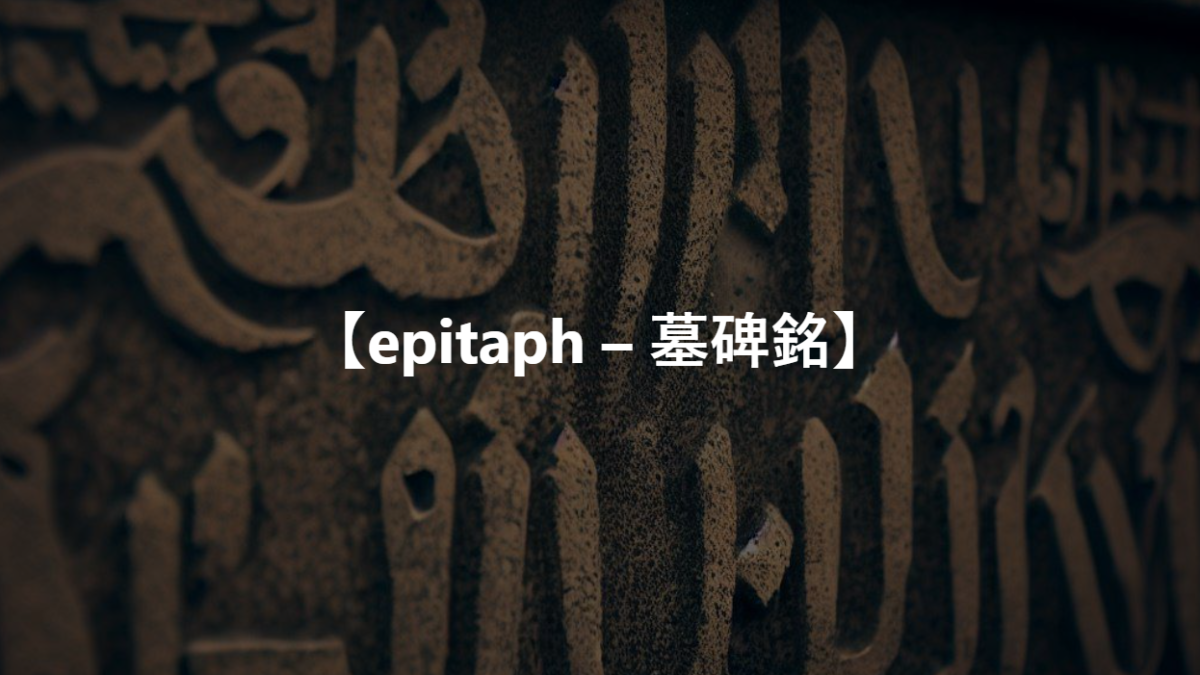語源・類義語・反対語・例文
【Epitaph – 墓碑銘】という単語の語源とか由来を知っていますか?
「Epitaph」は、古代ギリシャ語の「επιτάφιος(epitaphios)」に由来します。これは、文字通り「墓の上に置かれたもの」という意味で、元々は葬儀の場で死者をたたえるために朗唱された讃歌を指しました。その後、この単語は死者の墓に刻まれる銘文を指すようになり、現代の英語においては「墓碑銘」を意味するようになりました。
“Epitaph” originates from the ancient Greek “επιτάφιος (epitaphios),” which literally means “placed over a tomb,” originally referring to an elegy recited at funerals to praise the deceased. Subsequently, the word came to denote the inscription engraved on a person’s tomb and, in modern English, has come to mean “tombstone inscription.”
この単語の類義語・反対語を教えてください。
類義語
- Eulogy: 賛辞。一般に、人の死後にその人の生涯や成就を称えるために読まれる文章やスピーチ。墓碑銘(epitaph)と同様に、故人を記念するものですが、eulogyは葬儀などで口頭で述べられることが多いです。
- Inscription: 銘文。物体に刻まれた文字や言葉。epitaphは特に墓石に刻まれる銘文を指しますが、inscriptionはより広い用途で使われます。
- Tribute: 賛辞、敬意。故人への尊敬や感謝を表す言葉や行動。epitaphと同様に、故人を称える意味合いを持ちますが、形式や文脈が異なることがあります。
反対語
- Criticism: 批判。人の行動や性格、成果などに対する否定的な評価やコメント。epitaphが故人を称えるのに対し、criticismはその人のマイナス面を指摘することがあります。
- Defamation: 名誉毀損。虚偽の情報を流布して人の名誉を傷つける行為。epitaphが故人に敬意を表するのに対し、defamationは故意に人を貶めることを意味します。
似た単語で間違いやすい単語はありますか?
- Eulogy: 賛辞、追悼の辞。一般に、葬儀や追悼式で故人を称えるために口頭で述べられるスピーチです。「Epitaph」とは異なり、口頭で伝えられる点が特徴です。
- Obituary: 死亡記事。新聞やウェブサイトに掲載される、故人の生涯や業績を記した記事です。「Epitaph」とは異なり、公的な媒体で故人の生涯を紹介する文書を指します。
- Inscription: 銘文。物体に刻まれた文字や言葉を指します。墓石に刻まれる「Epitaph」も「Inscription」の一種ですが、「Inscription」は墓石以外にも、記念碑や贈り物など様々な物体に適用される広範な用語です。
- Tombstone: 墓石。墓地に立てられる、故人の名前や生没年、場合によっては「Epitaph」が刻まれる石です。「Epitaph」と混同しやすいですが、「Tombstone」は物理的なオブジェクトを、「Epitaph」はその上に刻まれる文言を指します。
- Memorial: 記念碑または記念物。故人や出来事を記念して建てられた構造物やオブジェクトです。「Epitaph」が個々の墓石に刻まれる文言を指すのに対し、「Memorial」はより広い範囲で記念の意味を持つ物体や場所全体を指します。
この単語を使った例文
“His epitaph reads, ‘Here lies a man who loved life and laughter.'”
彼の墓碑銘には「ここに人生と笑いを愛した男が眠る」と刻まれています。
“She chose a beautiful quote as her epitaph to inspire those who visited her grave.”
彼女は自分の墓を訪れる人々に感動を与えるために、美しい引用句を墓碑銘として選びました。
“The epitaph on the old tombstone was faded and hard to read.”
古い墓石の墓碑銘は色褪せており、読むのが難しかったです。
“They decided to write a simple yet profound epitaph for their beloved pet.”
彼らは愛するペットのために、シンプルだが意味深い墓碑銘を書くことに決めました。
“The poet’s epitaph was a verse from one of his most famous poems.”
その詩人の墓碑銘は、彼の最も有名な詩の一節でした。
【epitaph – 墓碑銘】のコロケーション
- Write an epitaph: 墓碑銘を書く。このフレーズは、故人の墓石に刻むためのメッセージや言葉を作成する行為を指します。これは、故人を記念し、彼らの人生や精神を反映した文を書くプロセスです。
- Read an epitaph: 墓碑銘を読む。故人の墓石に刻まれた墓碑銘を読む行為を指します。これは、墓地を訪れた際に行われ、故人を思い出す機会を提供します。
- Choose an epitaph: 墓碑銘を選ぶ。自分自身や他の人のための墓碑銘を選ぶプロセスを指します。これには、故人の人生や価値観を最もよく表現する言葉やフレーズを選ぶことが含まれます。
- Inscribe an epitaph: 墓碑銘を刻む。墓石に墓碑銘を彫り込む行為を指します。これは、永続的な記念として、故人の名前、生没年、および記念の言葉を墓石に記録するプロセスです。
- Design an epitaph: 墓碑銘をデザインする。墓碑銘の文言だけでなく、その書体やレイアウトを考えるプロセスを指します。これにより、故人の墓石がより個人的で意味のあるものになります。
「epitaph – 墓碑銘」という言葉は、亡くなった人々を追悼する際に関連するさまざまな側面や習慣を強調するいくつかの一般的なコロケーションと組み合わされています。これらの組み合わせを理解することで、墓碑銘の文化的および個人的な意義に関する洞察が得られます。
「Write an epitaph」は、人の墓石に刻むためのメッセージや言葉を作成する行為を指します。このプロセスには、故人の生涯と精神を追悼し、反映するテキストを作成することが含まれます。
「Read an epitaph」は、墓石に刻まれた銘文を読む行為を指し、通常、墓地を訪れる際に行われます。この行為は、亡くなった人を思い出し、称える機会を提供します。
「Choose an epitaph」は、自分自身や他人の墓石のために適切な言葉やフレーズを選ぶプロセスを指します。この選択プロセスは、故人の生涯と価値観の本質を要約するために重要です。
「Inscribe an epitaph」は、選ばれた言葉を墓石に彫り込む行為を指します。この永続的な行為は、故人の名前、生没年、そして追悼の言葉やメッセージを石に記録することで、永続的な記念として機能します。
「Design an epitaph」は、墓碑銘の言葉遣いだけでなく、その書体やレイアウトを考慮するプロセスを包括します。このプロセスにより、墓石の最終的な外観が、故人へのより個人的で意味深い賛辞になります。
これらのコロケーションは、「epitaph」が亡くなった人々の遺産を追悼し、称える文脈でどのように使用されるかを示しています。各表現は、墓碑銘の概念に関連するさまざまな活動や意図を強調し、記憶を保存し、喪失や敬意の感情を表現する役割を示しています。
The term “epitaph ” is paired with several common collocations that highlight different aspects and practices associated with commemorating deceased individuals. Understanding these combinations offers insight into the cultural and personal significance of epitaphs.
“Write an epitaph” refers to the act of crafting a message or words to be engraved on a person’s tombstone. This process involves creating a text that commemorates and reflects the life and spirit of the deceased.
“Read an epitaph” denotes the action of reading the inscriptions on a tombstone, typically performed when visiting a graveyard. This act provides an opportunity to remember and honor the person who has passed away.
“Choose an epitaph” involves selecting the appropriate words or phrases for one’s own or another’s tombstone. This selection process is crucial for encapsulating the essence of the deceased’s life and values.
“Inscribe an epitaph” points to the physical act of engraving the chosen words onto a gravestone. This permanent act serves as a lasting memorial, recording the name, birth and death dates, and a commemorative phrase or message on the stone.
“Design an epitaph” encompasses not just the wording of the epitaph but also its typography and layout. This process ensures that the final appearance of the tombstone becomes a more personal and meaningful tribute to the deceased.
These collocations illustrate how the term “epitaph” is utilized within contexts related to memorializing and paying tribute to the legacy of deceased individuals. Each expression highlights various activities and intentions connected to the concept of epitaphs, demonstrating their role in preserving memories and expressing sentiments of loss and reverence.
文法問題: Epitaph (墓碑銘)
- The poet carefully crafted an [ ] for his beloved friend, capturing the essence of his life in a few poignant words.
- (A) epitaph
- (B) elegy
- (C) eulogy
- (D) obituary
解答と解説: (A) epitaph
epitaph は「墓碑銘」という意味で、故人の生涯や業績を短く刻んだ言葉です。elegy は「哀歌」、eulogy は「追悼の辞」、obituary は「死亡記事」という意味で、文脈に合いません。
- The tombstone bore a simple yet moving [ ] that read, “Beloved mother and friend.”
- (A) epitaph
- (B) inscription
- (C) engraving
- (D) etching
解答と解説: (A) epitaph
epitaph は墓石に刻まれた言葉で、「Beloved mother and friend」のような簡潔で感動的な言葉は墓碑銘にふさわしいです。inscription は「碑文」、engraving は「彫刻」、etching は「エッチング」という意味で、墓石に刻まれた言葉としては一般的ではありません。
- The historian was fascinated by the ancient [ ] found in the ruins of the Roman city.
- (A) epitaphs
- (B) manuscripts
- (C) artifacts
- (D) relics
解答と解説: (A) epitaphs
epitaphs は epitaph の複数形で、ここではローマ時代の遺跡で見つかった複数の墓碑銘を指しています。manuscripts は「原稿」、artifacts は「人工物」、relics は「遺物」という意味で、文脈に合いません。
- The [ ] on the gravestone was so worn by time that it was barely legible.
- (A) epitaph
- (B) inscription
- (C) engraving
- (D) etching
解答と解説: (A) epitaph
epitaph は墓石に刻まれた言葉です。この文脈では、時間の経過によって墓碑銘が読みにくくなっていることを示しています。
- The family chose a [ ] that celebrated the deceased’s love of nature and his passion for adventure.
- (A) epitaph
- (B) eulogy
- (C) elegy
- (D) obituary
解答と解説: (A) epitaph
epitaph は故人の特徴や業績を短くまとめた言葉で、故人の人生を称えるために選ばれます。eulogy は「追悼の辞」、elegy は「哀歌」、obituary は「死亡記事」という意味で、文脈に合いません。

